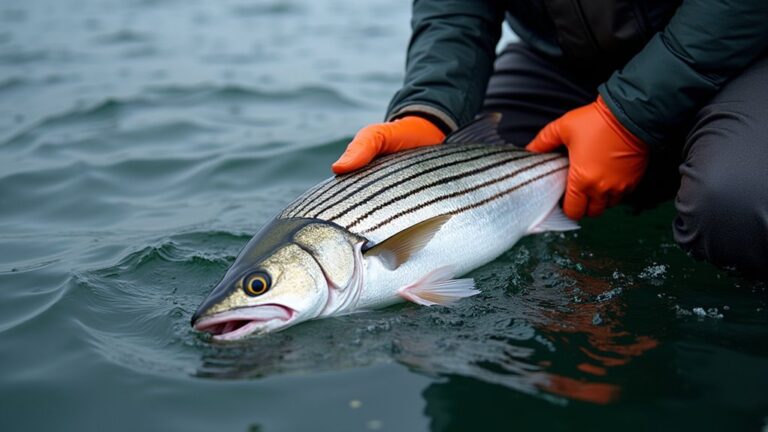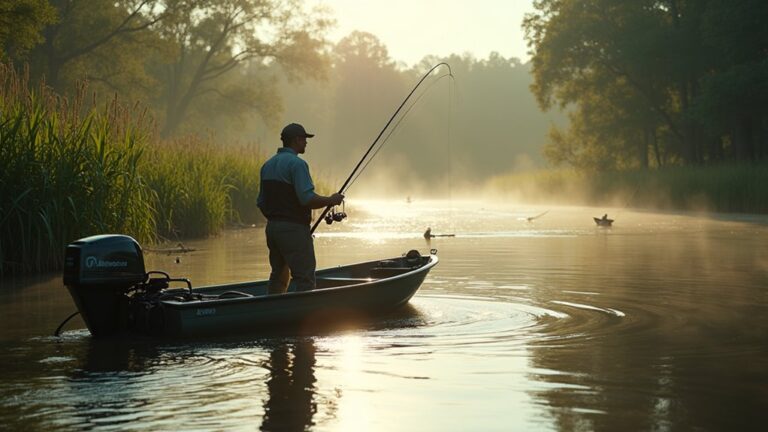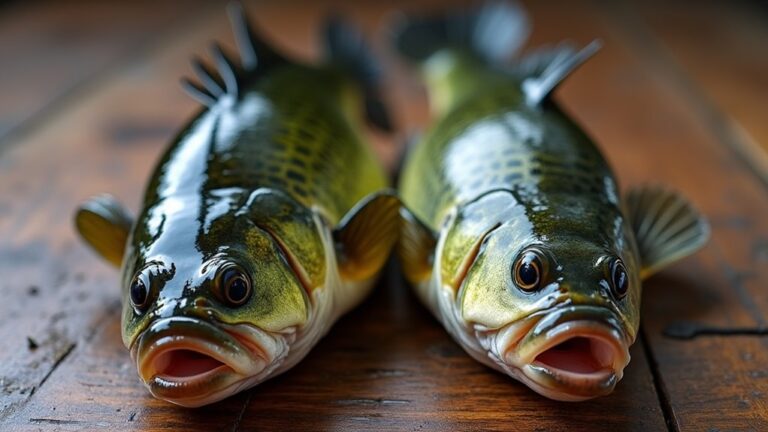In New England's coastal waters, you'll encounter seven common saltwater fish species that offer diverse angling experiences. You can target the prized striped bass, known for thrilling fights, or chase aggressive bluefish for an exciting catch. Rocky bottoms host tautog, while reefs harbor black sea bass. Summer brings fluke, offering both challenge and flavor. Scup are party boat favorites, perfect for casual fishing trips. Don't forget the iconic cod, though subject to strict regulations. Each species has its unique habitat, preferred bait, and fishing techniques. Dive deeper to reveal the secrets of these marine treasures and enhance your fishing adventures.
Striped Bass: The Coastal King
Nearly every angler in New England knows the Striped Bass as the "Coastal King." These prized fish can range from a modest 1 pound to an impressive 60+ pounds, making them a favorite for both sport fishing and dining.
Known for their aggressive feeding behavior, striped bass are often found in areas where they can ambush prey, making them a thrilling catch for anglers. You'll find striped bass throughout New England's coastal and estuarine waters, inhabiting diverse environments like surf zones, bars, reefs, bays, and estuaries.
For recreational anglers, the active fishing season runs from mid-April to October. Whether you're fishing from boats or the shore, you'll have ample opportunities to catch these sought-after fish. To increase your chances of success, try using preferred baits such as seaworms, eels, squid, or herring. If you prefer artificial lures, jigs, plugs, spinners, and spoons can be highly effective.
Additionally, understanding local saltwater fish regulations is essential for responsible fishing practices.
What makes striped bass particularly exciting is their aggressive feeding behavior. When you hook one, be prepared for a thrilling fight that'll test your skills and equipment. Their combative nature, combined with their widespread presence in New England waters, makes them a top target for anglers seeking both challenge and reward in their fishing expeditions.
Bluefish: Aggressive and Abundant
Aggression defines the bluefish, a saltwater powerhouse that's as abundant as it's ferocious. Found along New England's coastal waters from Cape Cod to Argentina, these fish are a favorite among recreational anglers.
Scientifically known as Pomatomus saltatrix, bluefish typically weigh between 3 to 7 pounds, but can grow larger, offering an exciting challenge for fishing enthusiasts. Their habitat in estuaries and coastal areas makes them easily accessible to anglers, and their aggressive nature often leads to thrilling encounters.
When you're planning your New England fishing trip, keep these bluefish facts in mind:
- Peak season runs from June to mid-October
- They're known for their aggressive feeding behavior
- Wire leaders are recommended due to their sharp teeth
You'll find bluefish are strong fighters, making them a thrilling catch. Their aggressive nature means they'll readily strike at various baits, including small bait fish, jigs, and plugs.
As you cast your line into the coastal waters, be prepared for an intense battle – bluefish are notorious for their powerful runs and acrobatic leaps. For those looking to enhance their fishing tactics, understanding best fishing techniques can improve your success rate.
Whether you're a seasoned angler or a newcomer to saltwater fishing, targeting bluefish in New England waters promises an exhilarating experience. Their abundance and fighting spirit make them a perfect species for both sport and recreational fishing enthusiasts.
Tautog: Rocky Bottom Dwellers
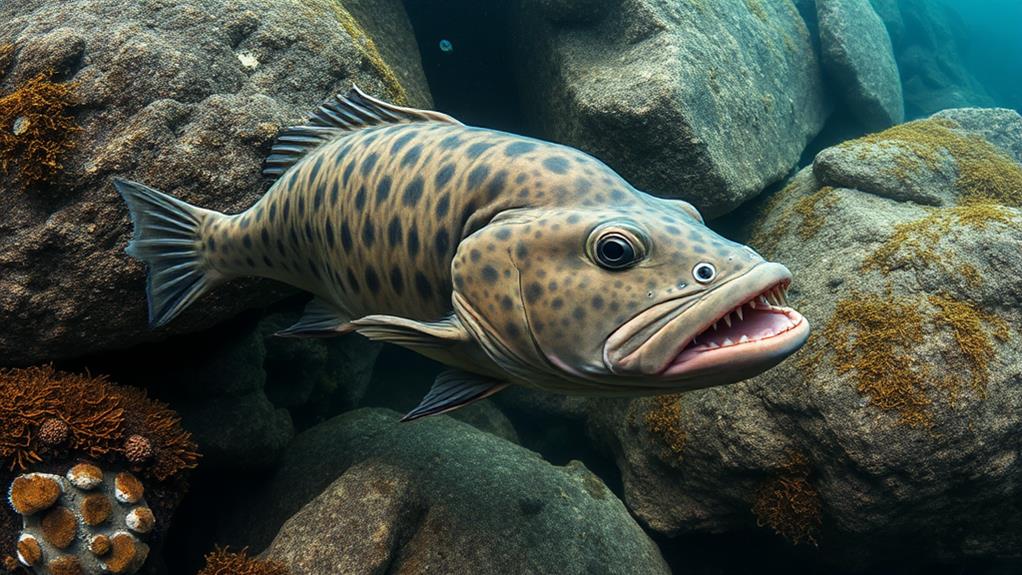
Lurking among the rocky bottoms of New England's coastal waters, you'll find the tautog, a stout-bodied fish also known as blackfish. These slow-growing creatures thrive in bays, harbors, jetties, and breakwaters, making them a common sight along the coast.
You'll have the best chance of catching tautog from April to November when they're most active.
If you're targeting tautog, you'll need to use still-fishing techniques from either a boat or the shore. Opt for medium action tackle and bait your hook with crabs, clams, or other shellfish to entice these bottom dwellers.
Keep in mind that tautog can be challenging to catch due to their rocky habitat preferences, but their excellent taste makes the effort worthwhile.
When fishing for tautog, look for fish around 10 inches long, as they've likely reached sexual maturity at this size. While the average tautog weighs between 1-3 pounds, you might get lucky and reel in a monster up to 25 pounds.
With their thick lips and preference for rocky bottoms, tautog offer a unique angling experience in New England's saltwater.
Black Sea Bass: Reef Favorites
A favorite among anglers and seafood enthusiasts alike, the Black Sea Bass is a prized catch in New England's coastal waters. This migratory species arrives in late spring, making its home around reefs and rocky bottoms. You'll find them in abundance along the South side of Cape Cod, in Buzzards Bay, and near the Rhode Island border.
Understanding essential gear and preparation can enhance your fishing experience, as these fish are often targeted with specific tackle designed for bottom fishing.
Black Sea Bass offer unique characteristics that make them fascinating to catch:
- They're known for their delicious taste
- They can change from female to male around three years old
- Their fishing season runs from May to September
When you're targeting Black Sea Bass, focus on bottom habitat fishing methods. They're particularly fond of cut squid, clams, and green crabs as bait.
As you plan your fishing trips, remember that these fish prefer specific locations and bottom structures. To increase your chances of a successful catch, head out to Cape Cod Bay or Buzzards Bay during the warmer months.
Keep in mind that Black Sea Bass are attracted to reefs and rocky areas, so scout out these locations for the best results. With the right approach and knowledge of their habits, you'll be well-equipped to reel in these popular saltwater fish.
Fluke: Summer Flounder Delights
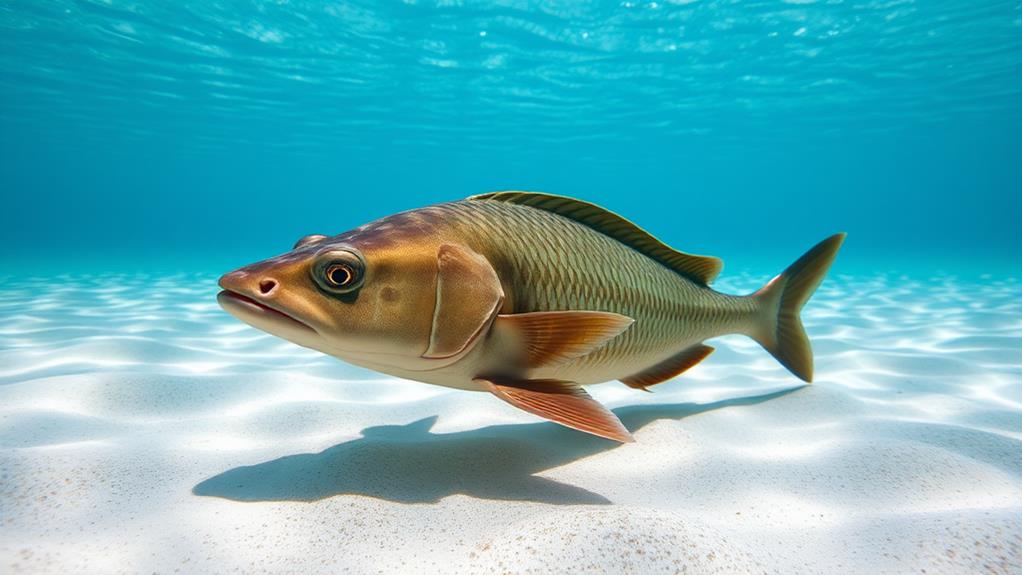
Summer brings a delightful treat for New England anglers: the Fluke, also known as Summer Flounder. You'll recognize this left-sided flounder by its distinctive pattern of 10-14 eye-like spots along its body. Typically weighing between 2-5 pounds, Fluke are prized for their delicious, flaky white flesh, making them a favorite among recreational fishing enthusiasts.
To catch these tasty fish, you'll want to head out from late spring to early fall when they're most abundant in coastal waters. Fluke migrate offshore to spawn, so you might need to venture into deeper waters for the best results.
When fishing for Fluke, try bottom fishing techniques using squid, minnows, or artificial lures. Drifting is another effective method to entice these bottom-dwelling fish.
Female Fluke reach maturity at around 17 inches, so be sure to follow local regulations to guarantee sustainable fishing practices.
Whether you're an experienced angler or a novice, pursuing Summer Flounder offers an exciting challenge and a potentially delectable reward. So grab your gear and hit the water – you might just reel in your next memorable catch!
Scup: Party Boat Staples
While Fluke may be the stars of summer, another fish takes center stage on New England's party boats: the Scup.
These Atlantic waters residents, scientifically known as Stenotomus chrysops, are a popular catch among recreational anglers. You'll find them swimming along the inner continental shelf from Massachusetts to South Carolina, where they spawn and thrive.
If you're planning to join the scup fishing frenzy, keep these key points in mind:
- The fishing season runs from May to October, aligning with their migration patterns
- Light tackle is preferred, paired with common baits like clams, squid strips, and seaworms
- Scup can grow up to 18 inches and weigh between 1-4 lbs, making for an exciting catch
What makes scup a party boat staple? It's not just their abundance – it's their taste.
These fish are highly regarded for their delicious flavor, making them a prized catch for anglers of all skill levels.
Cod: New England's Iconic Fish
Casting a line for New England's most iconic fish, you're likely to hook into a cod. The Atlantic cod, with its mild flavor and flaky texture, has been a cornerstone of the region's fishing history.
You'll find these fish thriving in cool waters at depths ranging from 75 to over 450 feet, often lurking around rocky ledges and gravel bottoms.
When you're planning your cod fishing trip, aim for the season that typically runs from May to November. You'll want to use baits like seaworms, clams, or jigs to entice these bottom-dwellers.
While you might dream of catching a monster cod up to 6 feet long and weighing over 200 pounds, most catches are considerably smaller.
Be aware that cod populations have faced challenges due to overfishing. As a result, you'll need to follow strict regulations on catch limits and size restrictions.
These measures are in place to help replenish dwindling populations and guarantee sustainable fishing practices. By adhering to these rules, you're contributing to the preservation of New England's iconic cod for future generations to enjoy.
Conclusion
You've encountered seven of New England's most common saltwater fish, but there's still so much more to discover. Will you venture deeper into the Atlantic's mysteries? What other finned wonders await in the cold, dark depths? The ocean holds countless secrets, and you're just scratching the surface. Who knows what rare species or record-breaking catches might be on your next fishing trip? The possibilities are as vast as the sea itself.


